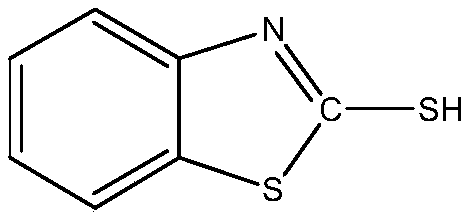Accelerator M modified alkylphenol-formaldehyde resin, and preparation method and application thereof
A formaldehyde resin, alkyl phenol technology, used in transportation and packaging, special tires, tire parts and other directions, can solve the problems of shortened scorch time, reduced vulcanization speed, etc., to achieve high atomic utilization rate, improved adhesion performance, The effect of increasing compatibility
- Summary
- Abstract
- Description
- Claims
- Application Information
AI Technical Summary
Problems solved by technology
Method used
Image
Examples
Embodiment 1
[0058] (1) Add 10g (0.06mol) accelerator M and 50ml absolute ethanol to a 100ml four-necked round-bottomed reaction flask equipped with a mechanical stirrer, a thermometer, a reflux condenser and an exhaust gas absorption device, and add sodium hydroxide after completely dissolving Solution (2wt%), adjust the pH to 11, keep the temperature at 10-12°C, slowly feed chlorine gas, and feed according to the molar ratio of promoter M and chlorine gas at 1:1. After the gas feeding was completed, the temperature was raised to 45° C., and the reaction was carried out for 1 hour. During the reaction, sodium hydroxide was continuously added to maintain a slightly alkaline environment (pH=8-11). Then, the reaction solution was poured into 500 g of cold water, allowed to stand for 1 hour, filtered, washed with cold water, and dried at 50° C. to obtain intermediate compound Z.
[0059] (2) Add 100 g (0.67 mol) p-tert-butylphenol and 0.5 g p-toluenesulfonic acid to a 250 ml four-necked roun...
Embodiment 2
[0062] (1) Add 10g (0.06mol) accelerator M and 50ml absolute ethanol to a 100ml four-necked round-bottomed reaction flask equipped with a mechanical stirrer, a thermometer, a reflux condenser and an exhaust gas absorption device, and add sodium hydroxide after completely dissolving Solution (2wt%), adjust the pH to 10, keep the temperature at 10-12°C, slowly feed chlorine gas, and feed according to the molar ratio of promoter M and chlorine gas at 1:1. After the gas feeding was completed, the temperature was raised to 40° C., and the reaction was carried out for 1 hour. During the reaction, sodium hydroxide was continuously added to maintain a slightly alkaline environment (pH=8-11). Then the reaction solution was poured into 500 g of cold water, allowed to stand for 1 hour, filtered, washed with cold water, and dried at 50° C. to obtain intermediate compound Z.
[0063] (2) Add 100 g (0.67 mol) p-tert-butylphenol and 0.5 g p-toluenesulfonic acid to a 250 ml four-necked round...
Embodiment 3
[0066] (1) Add 10g (0.06mol) accelerator M and 50ml absolute ethanol to a 100ml four-necked round-bottomed reaction flask equipped with a mechanical stirrer, a thermometer, a reflux condenser, and an exhaust gas absorption device to dissolve, and then add hydroxide Sodium solution (2wt%), adjust the pH to 11, keep the temperature at -5~0°C, slowly feed chlorine gas, and feed according to the molar ratio of accelerator M and chlorine gas at 1:1. After the gas feeding was completed, the temperature was raised to 60° C., and the reaction was carried out for 1 hour. During the reaction process, sodium hydroxide solution was continuously added to maintain a slightly alkaline environment (pH=8-11). Then the reaction solution was poured into 500 g of cold water, allowed to stand for 1 hour, filtered, washed with cold water, and dried at 50° C. to obtain intermediate compound Z.
[0067] (2) Add 100 g (0.67 mol) p-tert-butylphenol and 0.5 g p-toluenesulfonic acid to a 250 ml four-nec...
PUM
| Property | Measurement | Unit |
|---|---|---|
| Softening point | aaaaa | aaaaa |
| Softening point | aaaaa | aaaaa |
| Softening point | aaaaa | aaaaa |
Abstract
Description
Claims
Application Information
 Login to View More
Login to View More - R&D Engineer
- R&D Manager
- IP Professional
- Industry Leading Data Capabilities
- Powerful AI technology
- Patent DNA Extraction
Browse by: Latest US Patents, China's latest patents, Technical Efficacy Thesaurus, Application Domain, Technology Topic, Popular Technical Reports.
© 2024 PatSnap. All rights reserved.Legal|Privacy policy|Modern Slavery Act Transparency Statement|Sitemap|About US| Contact US: help@patsnap.com










